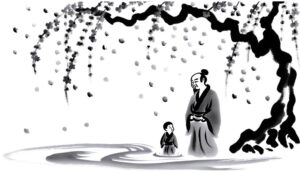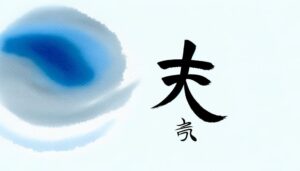What is the Japanese Symbol for Love?
The kanji symbol for love in Japanese is 愛 (ai). This character, deeply rooted in ancient Chinese script, encompasses rich historical and cultural significance.
It combines the elements of a heart (心), movement (動), and to receive (受), depicting love as emotionally profound and active. In literature, art, calligraphy, and daily life, 愛 reflects a multifaceted concept of love that includes romance, family bonds, and altruistic affection.
Its evolution and enduring relevance illustrate deep societal values in Japanese culture. To truly appreciate its nuances and varied applications, there is much more to explore.
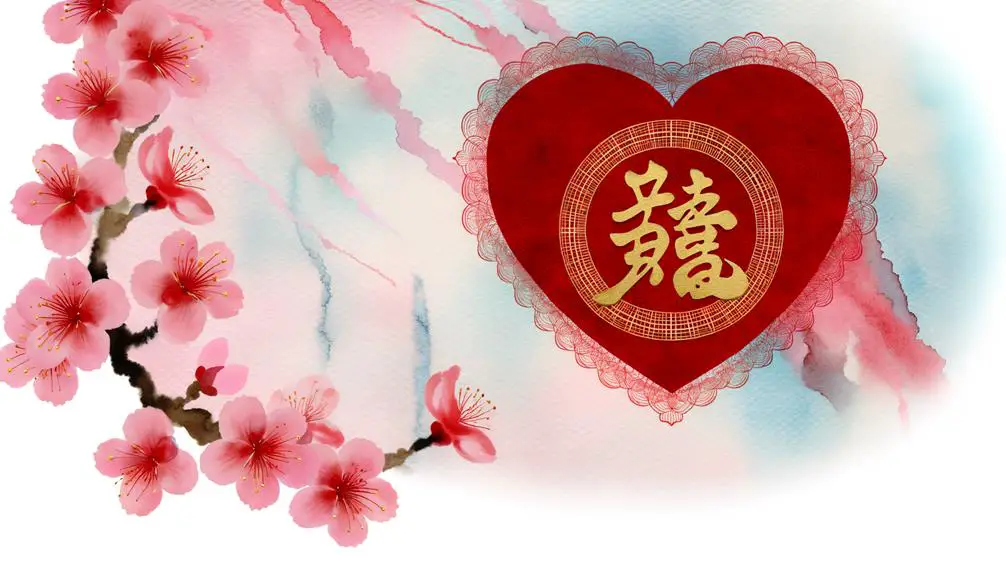
Key Takeaways
- The Japanese kanji for love is 愛 (ai), which combines heart, action, and protection.
- 愛 (ai) symbolizes romantic love, familial affection, and compassionate care in Japanese culture.
- It has historical roots from Chinese pictographs, reflecting deep emotional connections and cultural values.
- 愛 (ai) appears in Japanese literature, art, and calligraphy, enhancing emotional resonance.
- In modern media and daily life, 愛 (ai) represents enduring love and compassion in various contexts.
Historical Background
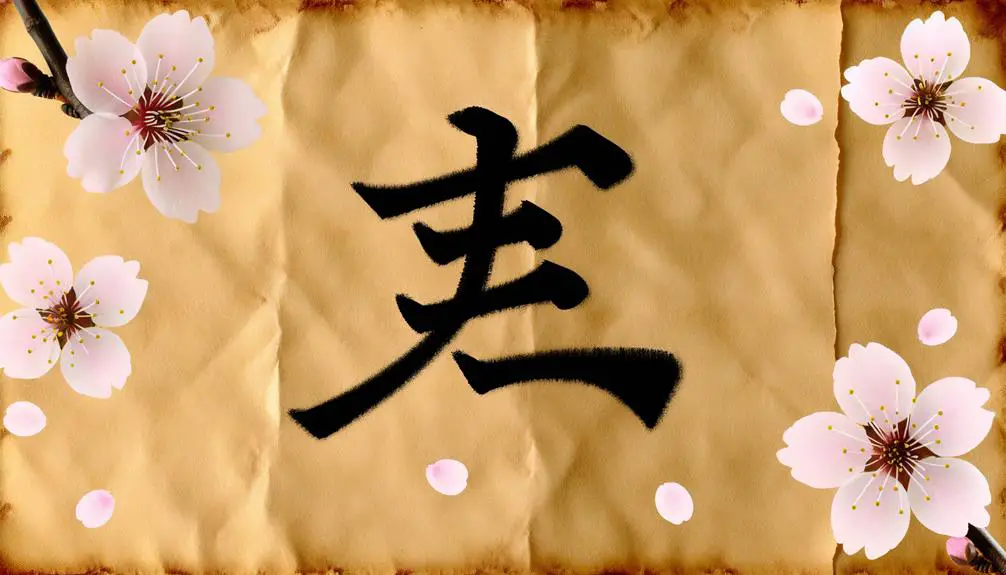
The historical background of the symbol for love in Japanese, encapsulated by the kanji character '愛' (ai), dates back to ancient Chinese script and has evolved greatly over centuries.
Originating from Chinese pictographs used during the Shang and Zhou dynasties, the character initially represented a complex interplay of emotions and social bonds. As the script shifted through various dynasties, it adopted more abstract and simplified forms.
When the Japanese kanji system was developed, many Chinese characters, including '愛', were incorporated. Over time, '愛' in Japanese culture has come to represent not only romantic love but also profound affection and compassion.
This rich historical evolution reflects the character's enduring significance across different eras and cultural contexts.
Etymology of 愛
The character 愛 (愛) for love holds a rich etymological history, originating from ancient Chinese script and evolving over centuries.
This symbol not only encapsulates deep emotional connection but also carries substantial cultural weight, reflecting societal values and philosophies.
Understanding its historical roots and the layers of meaning attributed to it offers a glimpse into the profound role love plays in both personal relationships and broader cultural contexts.
Historical Origins Explained
Tracing the historical origins of the Japanese symbol for love, 愛 (ai), reveals a rich tapestry of linguistic evolution and cultural significance.
The character 愛 is composed of three elements: 心 (kokoro, meaning 'heart'), 夂 (suinyou, representing 'movement'), and 受 (uke, indicating 'to receive'). This complex amalgamation suggests a deeply rooted notion of love as an emotional experience intertwined with action and receptivity.
Originating from ancient Chinese script, 愛 was adopted into Japanese kanji, maintaining its semantic essence while adapting to cultural nuances. Over centuries, the character 愛 has evolved in form but remains steadfast in symbolizing profound emotional attachment, reflecting both personal affection and broader humanistic values within Japanese society.
Cultural Significance Detailed
Examining the etymology of 愛 (ai) reveals a multifaceted cultural significance, reflecting the intricate blend of emotional depth and philosophical thought inherent in the Japanese conception of love.
The kanji 愛 is composed of three elements:
- 心 (kokoro): Representing the heart, this component underscores the emotional and heartfelt nature of love.
- 夂 (shi): This element implies action or movement, suggesting that love is not static but an active and dynamic force.
- 冖 (kanmuri): Symbolizing a roof or protection, it conveys the idea of love as a sheltering and nurturing presence.
Together, these components depict love as an emotionally profound, active, and protective experience, encapsulating the rich cultural and philosophical fabric of Japanese society.
愛 in Literature
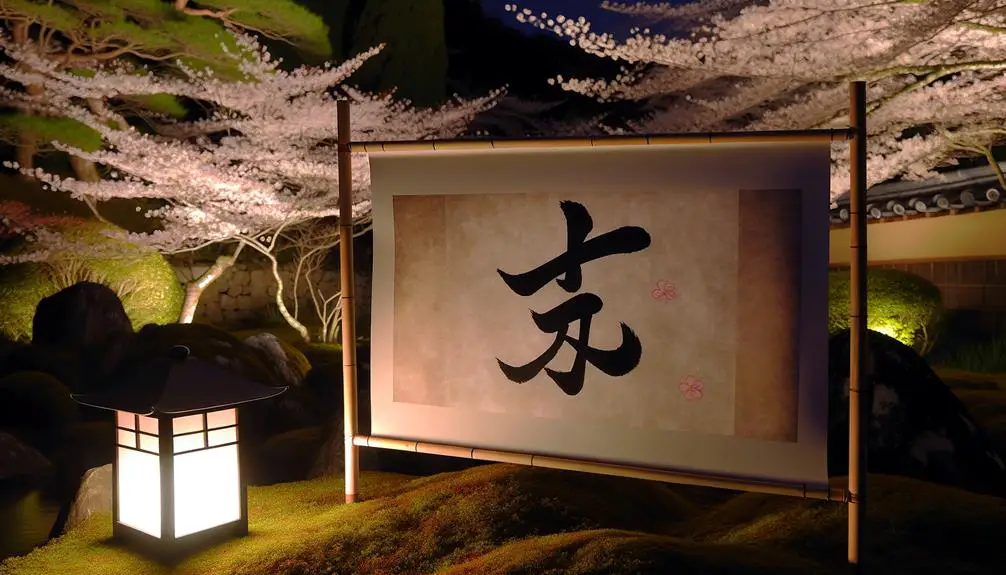
Incorporating 愛 into literature often serves to deepen the emotional resonance and cultural context of a narrative, reflecting the profound and multifaceted nature of love in Japanese society.
This kanji, symbolizing love, appears in various literary works, from classical poetry to contemporary novels, illustrating themes of romantic passion, familial bonds, and platonic affection.
For instance, the revered poet Matsuo Bashō and modern novelist Haruki Murakami explore 愛 to portray complex human emotions and relationships. Through its use, authors can evoke a deeper connection with readers, allowing them to experience the universal yet uniquely Japanese perspectives on love.
This nuanced representation enhances the literary richness, making 愛 an indispensable element in the tapestry of Japanese literature.
愛 in Art
The kanji 愛, symbolizing love, manifests in various art forms, embodying the profound emotional and cultural dimensions inherent to Japanese aesthetics. Its presence can be prominently seen in:
- Traditional Paintings: Artists intricately incorporate 愛 into serene landscapes or portraits to evoke a deep sense of connection and affection.
- Ceramics: Pottery often features the kanji 愛, symbolizing the love and care invested in the craftsmanship, making each piece unique and meaningful.
- Textiles: Kimonos and other traditional garments frequently showcase 愛, blending visual beauty with cultural significance, showcasing love in both tangible and symbolic forms.
Through these mediums, 愛 transcends mere symbolism, becoming an integral element of artistic expression, resonating deeply within Japanese culture.
愛 in Calligraphy
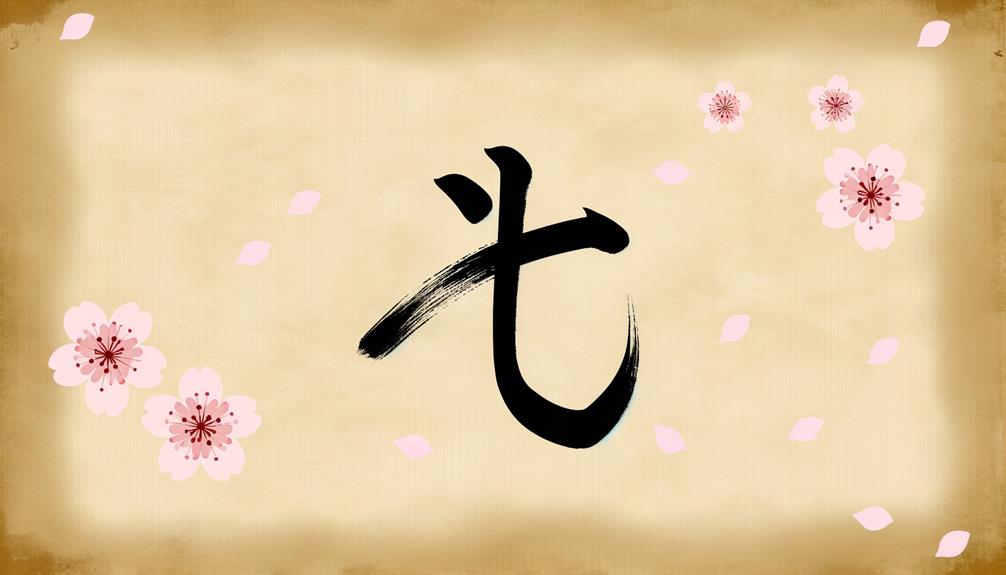
Exploring the essence of 愛 through calligraphy reveals the profound skill and emotional depth required to convey love within the elegant brushstrokes of this revered art form. Calligraphy transforms the character 愛 into a visual symphony, where each stroke carries intentional weight and meaning. The brush's movement, pressure, and rhythm reflect the calligrapher's emotions and mastery.
| Aspect | Description |
|---|---|
| Brush Technique | Varies to express different intensities of love |
| Stroke Order | Critical for achieving the character's aesthetic balance |
| Ink Consistency | Reflects the fluidity and depth of emotion |
| Paper Quality | Influences the texture and absorption of the ink |
| Emotional Expression | Captures the calligrapher's personal connection to the concept of love |
This intricate process embodies the timeless and universal nature of love, as articulated through Japanese calligraphy.
愛 in Modern Media
Building on the rich tradition of calligraphy, the character 愛 (ai) finds new life and relevance in modern media, where it continues to symbolize love in various contemporary contexts. This ancient symbol is prominently featured across diverse platforms, reflecting its enduring significance.
- Anime and Manga: The character 愛 is frequently depicted in storylines and titles, embodying themes of romantic and platonic love.
- Social Media: Emojis and digital stickers incorporating 愛 are popular in messaging apps, enhancing emotional expression in communication.
- Fashion and Merchandise: The character appears on clothing, accessories, and home décor, appealing to consumers' desire for meaningful and aesthetic designs.
In these ways, 愛 seamlessly integrates into modern culture, bridging traditional values with present-day expressions.
愛 in Daily Life
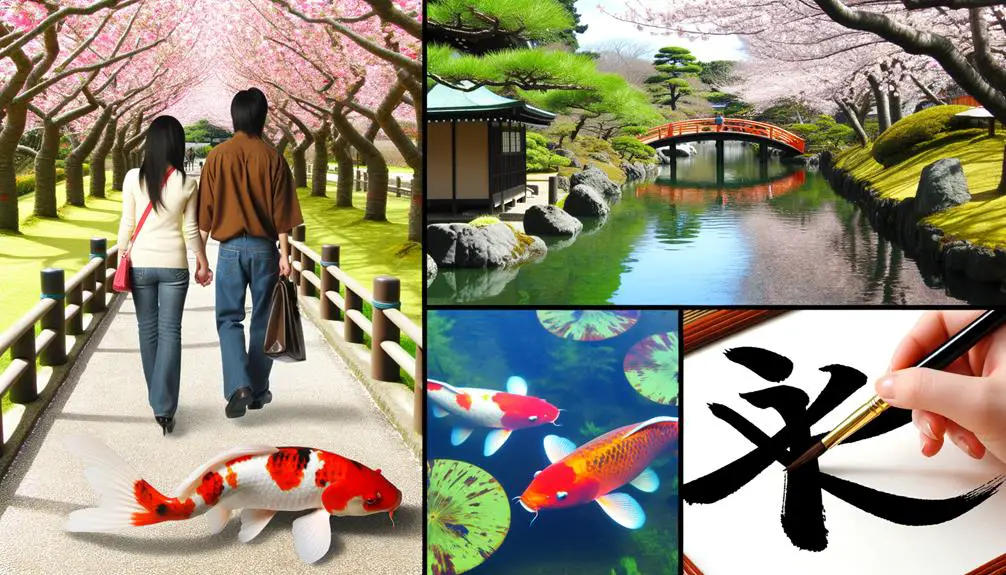
Incorporating 愛 (愛) into everyday life, individuals often express this profound concept through various personal and interpersonal actions, enriching their daily interactions with deeper emotional connections. Aspects of daily life where 愛 is evident include acts of kindness, thoughtful communication, and the nurture of oneself and others.
| Aspect | Description | Example |
|---|---|---|
| Acts of Kindness | Small gestures that show care and consideration | Helping a neighbor |
| Thoughtful Communication | Expressing empathy and understanding | Active listening |
| Self and Other Care | Prioritizing well-being and emotional support | Encouraging self-care routines |
Such practices not only enhance personal fulfillment but also foster a community atmosphere grounded in compassion and mutual respect. In this way, 愛 transcends mere feeling, embedding itself as a guiding principle in everyday actions.
愛 in Relationships
In the context of relationships, the kanji 愛 carries deep cultural significance, often representing a profound and enduring form of love.
This symbol transcends mere words, manifesting in actions that convey commitment, care, and mutual respect.
Understanding how 愛 is expressed in Japanese relationships offers valuable insights into the societal norms and emotional depth that characterize these connections.
Cultural Significance of 愛
Understanding the cultural significance of 愛 (ai) in relationships reveals the deep emotional and philosophical layers embedded within Japanese society's perception of love. This multifaceted character encompasses not only romantic love but also a broader sense of compassionate, altruistic affection.
- Familial Affection: 愛 (ai) often signifies the love between family members, emphasizing duty, respect, and unconditional support.
- Platonic Bonds: In friendships, 愛 (ai) represents trust, loyalty, and mutual understanding, reflecting a profound sense of connection.
- Romantic Love: In romantic contexts, 愛 (ai) goes beyond mere attraction, embodying commitment, deep emotional intimacy, and a shared life journey.
Expressing 愛 in Actions
Demonstrating 愛 (ai) through actions within relationships involves a nuanced blend of gestures, behaviors, and commitments that convey deep emotional and ethical values. In Japanese culture, such expressions often manifest through acts of consideration and respect.
Simple yet significant actions like actively listening, showing empathy, and offering help without being asked, embody 愛. Additionally, maintaining harmony (wa) and prioritizing the well-being of loved ones are paramount. Rituals such as preparing a loved one's favorite meal or creating moments of shared silence can speak volumes.
These practices, rooted in sincerity and consistency, transcend verbal affirmations, embedding 愛 deeply within the fabric of interpersonal connections. Such actions emphasize that true love is demonstrated through unwavering support and thoughtful care.
愛 in Family
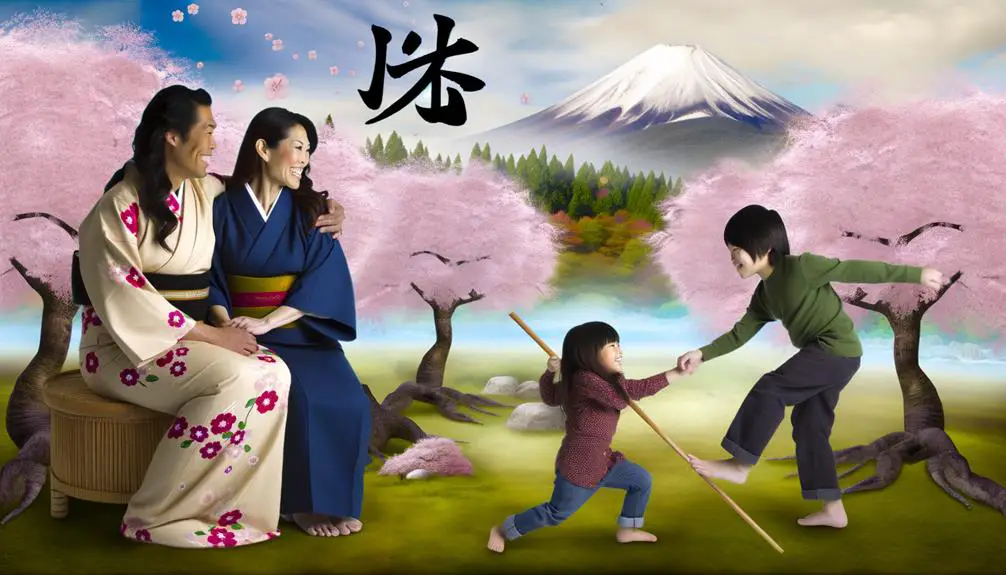
The kanji 愛, representing love, holds profound significance within the context of familial relationships in Japanese culture. This symbol encapsulates the deep emotional bonds and mutual respect that characterize family ties.
In Japanese households, 愛 is manifested through:
- Parental Affection: Parents express 愛 by nurturing and providing for their children, emphasizing education and moral development.
- Filial Piety: Children reciprocate this 愛 by showing respect and care for their parents, particularly as they age.
- Sibling Bonds: Siblings demonstrate 愛 through mutual support, cooperation, and maintaining harmony within the family unit.
These expressions of 愛 foster a cohesive family environment, integral to the social fabric. The nuanced application of 愛 guarantees lasting familial connections, underscoring its essential role in Japanese culture.
愛 in Society
In broader societal contexts, love extends beyond the family unit to encompass various forms of social interactions and communal harmony. This character represents a foundational element in Japanese culture, embodying compassion, empathy, and mutual respect within communities.
Love manifests in public etiquette, volunteerism, and social responsibility, reflecting a deep-seated cultural ethos that prioritizes collective well-being. Festivals, public ceremonies, and community activities often highlight love, reinforcing social bonds and fostering a sense of belonging.
Additionally, love is a guiding principle in professional environments, where teamwork and mutual support are highly valued. Overall, love operates as a key societal glue, promoting harmony and cooperation in diverse societal settings.
愛 in Language Learning
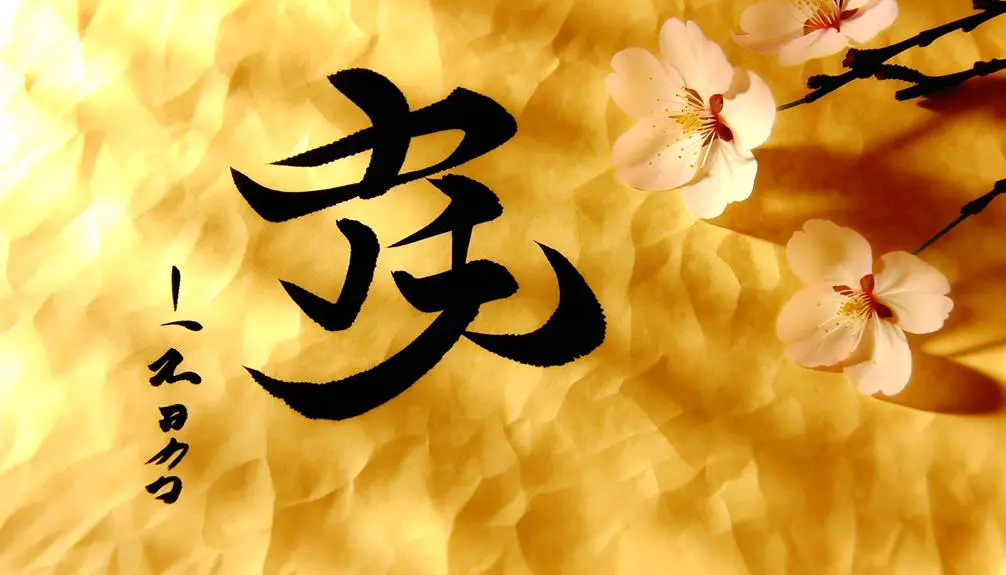
Building on its societal significance, 愛 also plays a pivotal role in language learning by offering a rich context for understanding cultural nuances and enhancing communication skills. For language learners, exploring 愛 can lead to deeper insights into Japanese culture and sentiments.
Key benefits include:
- Cultural Insight: Understanding 愛 allows learners to grasp the emotional depth and social importance of relationships in Japan.
- Vocabulary Expansion: Learning phrases and expressions involving 愛 enriches vocabulary and idiomatic usage.
- Contextual Understanding: 愛 provides a framework to practice language in meaningful contexts, fostering better retention and comprehension.
Symbolism in 愛
The kanji for love, 愛, is rich in symbolism, where each component contributes to its profound meaning. By examining its structure, one can see how the elements merge to convey notions of heart and action, reflecting the depth of emotional and physical dimensions of love.
This analysis, coupled with an understanding of its cultural significance in Japanese society, provides a nuanced appreciation of how 愛 transcends a mere linguistic sign to embody a cornerstone of human experience.
Kanji Components Breakdown
Breaking down the kanji for love, 愛 (ai), reveals a rich tapestry of symbolic components that collectively convey deep emotional and cultural significance.
The character is composed of several elements:
- 心 (kokoro) – meaning 'heart' or 'mind,' positioned centrally to signify the emotional core of love.
- 夂 (sui) – a radical that suggests movement or action, indicating that love is an active, dynamic force.
- 爫 (tsume) – resembling a hand, symbolizing the tangible, nurturing aspect of love through physical touch and care.
Each component of 愛 (ai) intricately weaves together to form a profound representation of love, capturing its multifaceted nature.
This layered structure offers a nuanced understanding of how love is perceived and expressed within Japanese culture.
Cultural Significance Explained
Within Japanese culture, the kanji for love (愛) embodies a rich tapestry of symbolism that reflects the profound and multifaceted nature of this emotion. Rooted in historical and philosophical contexts, 愛 is more than mere affection; it signifies deep relational bonds, compassion, and a sense of duty.
The character is often associated with familial love, social harmony, and even spiritual devotion. In literature and art, 愛 frequently appears to illustrate both romantic and platonic connections, emphasizing the importance of empathy and mutual respect.
Further, 愛 finds relevance in modern contexts, symbolizing the core values of community and collective well-being. This nuanced understanding underscores the cultural depth and timeless significance of 愛 in Japanese society.
Conclusion
In sum, the symbol for love in Japanese, 愛 (愛), carries a complex cultural connotation.
Historically honored, etymologically expressive, and artfully embedded in literature, art, calligraphy, family, and society, 愛 epitomizes emotional depth and relational resonance.
Its multifaceted presence in language learning underscores its universal significance.
The symbolism encapsulated in 愛 reflects a rich tapestry of tradition and transformation, testifying to the timeless tenacity of love within the Japanese cultural and linguistic landscape.


